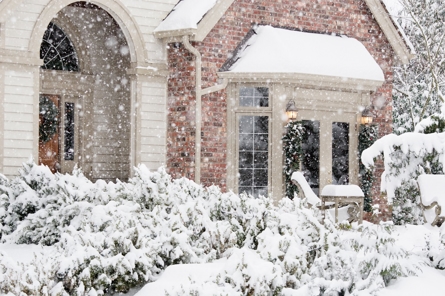
As winter approaches, the enchanting beauty of falling snow brings with it the potential for challenging weather conditions, including snowstorms. Proper preparation is key to ensuring your home remains a warm and secure place during these events. Learn how to prepare for a snowstorm, so that you, your family and your home stay protected this winter. From fortifying your exterior to creating an emergency kit, these proactive steps will help you face the snow with confidence and keep your household safe and comfortable.
Basic Snowstorm Preparedness
The basic snowstorm preparedness that will help keep your family and yourself safe starts with the following steps:
- Create an emergency kit with all the supplies you and your family might need during a disaster. Keep the kit in an easy to access location in your home. If you already have an emergency kit, add the following snow-related items:
- Rock salt or other products to melt ice on walkways.
- Sand to sprinkle on the snow and improve your traction, in the event you need to walk through it.
- Snow shovels and/or other snow removal equipment in case you need to exit through a snow-blocked door.
- Heating fuel. If a snowstorm is strong enough, your regular fuel sources might be cut off. Make sure you have ample dry, seasoned wood to use in your fireplace.
- Vehicle Preparedness. Check your vehicle's antifreeze, battery, and tires before the storm. Keep an emergency kit in your car, including blankets, snacks, and a fully charged phone. Avoid unnecessary travel during severe weather conditions.
- Make an emergency communications plan. If you listen to the news or stay up to date with local weather changes, you should have been given plenty of time to prepare for a snowstorm. However, in the event that your family members aren't together when a storm hits, it's crucial for everyone to know how to get in contact with one another and where you should meet once the weather clears.
- Prepare for Power Outages. Charge electronic devices and have portable chargers on hand. Keep a supply of candles, flashlights, and lanterns with extra batteries. If you have a generator, ensure it is in good working order.
Ensure you have enough clothing and blankets to keep warm during winter is essential for your comfort and well-being.
Winter coats: Invest in a good-quality winter coat that provides insulation and protection against cold temperatures.
Layered clothing: Layering is key for staying warm. Have a mix of thermal or moisture-wicking base layers, insulating layers, and a waterproof outer layer.
Sweaters and hoodies: Keep a collection of warm sweaters and hoodies for added insulation.
Insulated gloves: Protect your hands from the cold with insulated gloves or mittens.
Hats and beanies: Heat escapes through the head, so wear hats or beanies to keep warm.
Scarves: A scarf can provide extra warmth and protect your neck and face from harsh winds.
Thermal socks: Keep your feet warm with thermal or wool socks, especially if you'll be spending time outdoors.
Winter boots: Invest in waterproof and insulated winter boots to keep your feet dry and warm.
Thermal underwear: Thermal underwear is excellent for providing an extra layer of warmth, especially in extremely cold conditions.
Fleece-lined leggings or pants: For additional warmth, consider fleece-lined leggings or thermal pants.
Blankets and Bedding:
Warm Comforter or Duvet: Use a thick and warm comforter or duvet for your bed to provide extra insulation.
Flannel Sheets: Swap out lightweight sheets for flannel sheets to retain heat.
Electric Blanket: An electric blanket can be a cozy addition, allowing you to control the level of warmth.
Throw Blankets: Keep throw blankets on sofas and chairs for added warmth during leisure time.
Insulating Curtains: Use insulating curtains to keep cold drafts at bay and retain heat in your living spaces.
Draught Excluders: Place draught excluders at the bottom of doors to prevent cold air from entering.
Hot Water Bottles: A hot water bottle can provide localized warmth in your bed or while relaxing.
Layered Bedding: Layering bedding with extra blankets allows you to adjust warmth levels according to your comfort.
PREPARING YOUR HOME FOR A SNOWSTORM
There are several things you should do to prepare your home and surroundings prior to a snowstorm, too, including:
- Clean up outside. Anything you leave outside will get lost or buried by a lot of fresh snow, so bring everything you want to protect or need access to inside as soon as possible.
- Make sure your home will stay warm – especially if your typical fuel sources are cut off – by properly insulating walls and caulking and weatherstripping doors and windows.
- Insulate your home's pipes so they don't freeze and burst in cold weather.
- Clear your rain gutters of debris regularly to avoid more damage during a snowstorm.
- Sweep your chimneys and have them inspected every year to ensure they can effectively warm your home without the risk of chimney fire.
- Have your roof inspected to make sure it can handle the weight of accumulating snow this season. If it appears weak or structurally unsafe, repair your roof early to avoid future damage during a storm.
By taking these proactive measures, you can fortify your home against the challenges of a snowstorm and ensure the safety and well-being of your household. Stay warm, stay safe, and embrace the beauty of winter with peace of mind. In the unfortunate event that the unthinkable does occur, contact the experts at ServiceMaster Restore. Available 24/7/365 call 1-800-RESPOND, we will help guide you from crisis to resolution as quickly as possible.
